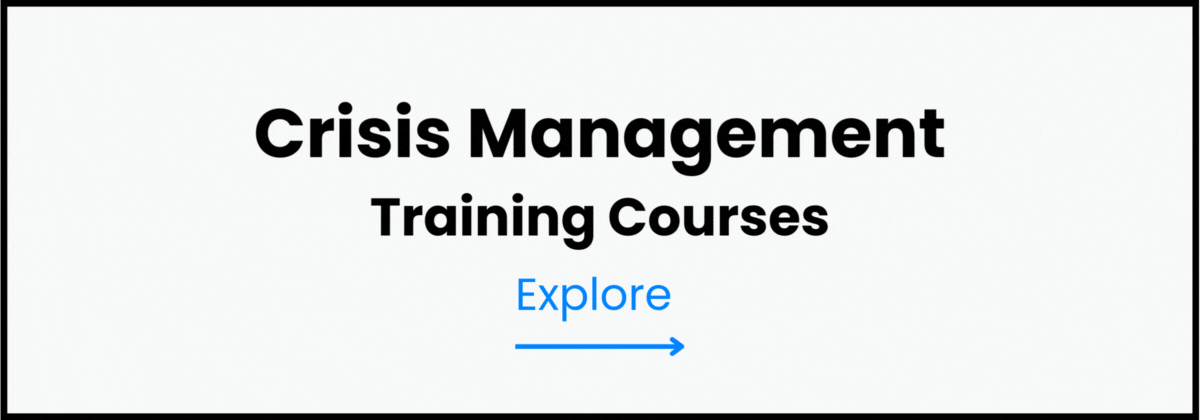Four Phases of Crisis Management Framework Explained
Mitigation, Preparedness, Response, Recovery
A crisis management framework is a structured approach that guides how an organization anticipates, manages, and recovers from disruptive events. It provides a clear roadmap for decision-making, communication, and coordination during emergencies — ensuring that teams act decisively and cohesively when it matters most.
At its core, the framework is built around four key phases: Mitigation, Preparedness, Response, and Recovery. Each phase plays a distinct yet interconnected role in strengthening resilience and maintaining operational stability during crises.
These stages are vital because they transform chaos into controlled action. By proactively reducing risks (Mitigation), building readiness (Preparedness), acting decisively under pressure (Response), and restoring normal operations efficiently (Recovery), organizations not only survive disruption but emerge stronger. Together, they form a continuous cycle of improvement — reinforcing business continuity, stakeholder confidence, and long-term resilience in an unpredictable world.
What is the Crisis Management Framework?
A crisis management framework serves as the structural foundation that guides how organizations prepare for, respond to, and recover from unexpected disruptions. It provides a clear and methodical approach to managing emergencies — ensuring that leadership, communication, and operational decisions remain aligned even under extreme pressure.
The framework’s purpose is to create a unified system of response that supports both risk management and business continuity planning. It ensures that potential threats are anticipated, roles are defined, and recovery processes are executed with precision. Whether the disruption comes in the form of a natural disaster, cyberattack, supply chain failure, or public relations crisis, the framework provides the blueprint for minimizing impact and maintaining trust.
In practical terms, it functions as both a crisis management process and an emergency management guide, outlining the stages of crisis management — from early risk mitigation to full operational recovery. By linking strategy, governance, and communication, the framework transforms reactive responses into structured, proactive management, ensuring the organization remains resilient, credible, and adaptive in the face of any challenge. (How to Develop a Crisis Management Plan?)
The 4 Phases of Crisis Management Framework
The crisis management framework operates through four interconnected phases that collectively reduce impact, protect reputation, and strengthen resilience. Each phase — Mitigation, Preparedness, Response, and Recovery — serves a distinct purpose in ensuring that organizations move from prevention to restoration in a structured and strategic manner.
-
Mitigation Phase — Reducing the Likelihood of a Crisis
The mitigation phase focuses on crisis prevention and risk reduction — addressing potential vulnerabilities before they escalate into full-blown crises. In this stage, organizations adopt a proactive management approach, identifying and minimizing threats through systematic assessment and preventive controls.
Key activities include:
- Conducting comprehensive risk identification and vulnerability analyses across operations.
- Implementing preventive measures such as cybersecurity upgrades, safety audits, and policy reviews.
- Strengthening supply chains and operational resilience through continuous monitoring and compliance checks.
Effective crisis mitigation reduces both the likelihood and severity of incidents, enabling organizations to focus resources where they matter most. By taking action before disruption occurs, businesses can build a strong foundation for stability and confidence.
-
Preparedness Phase — Building Capacity and Readiness
The preparedness phase emphasizes crisis readiness through detailed planning, training, and communication systems. Its goal is to ensure that when a crisis does occur, every employee, department, and stakeholder knows their role and can act swiftly.
Key preparedness strategies include:
- Developing contingency plans and emergency communication protocols for various crisis scenarios.
- Conducting training drills, tabletop exercises, and crisis simulation exercises to test readiness.
- Allocating necessary resources, including personnel, equipment, and funding, for rapid response.
- Cultivating a culture of readiness where leadership visibility and cross-functional collaboration are prioritized.
Strong crisis preparedness allows organizations to respond with coordination and confidence — turning potential chaos into well-organized action.
-
Response Phase — Managing the Crisis as It Unfolds
The response phase represents the moment of truth — when the crisis hits and the organization must execute its plans effectively. This stage demands clear leadership, rapid incident management, and a well-structured communication strategy to minimize confusion and misinformation.
Core elements of crisis response include:
- Activating emergency response teams and mobilizing the Crisis Management Team (CMT).
- Coordinating decisions and actions across departments to contain the crisis.
- Implementing transparent communication strategies — including timely internal briefings and media statements — to maintain stakeholder confidence.
- Prioritizing safety, business continuity, and compliance during all actions.
This phase requires decisive leadership and disciplined coordination. When executed effectively, emergency response measures limit operational damage and preserve the organization’s reputation.
-
Recovery Phase — Restoring Normalcy and Learning from the Crisis
The recovery phase focuses on crisis recovery, rebuilding operations, and restoring confidence once the immediate danger has passed. It bridges short-term stabilization with long-term resilience building and organizational learning.
Key recovery activities include:
- Implementing business continuity measures to resume critical operations.
- Managing logistics, financial recovery, and employee reintegration efforts.
- Conducting post-crisis evaluations and after-action reviews to identify lessons learned.
- Revising policies, updating crisis management plans, and enhancing response strategies based on insights gained.
A successful recovery phase not only restores normalcy but also strengthens preparedness for future challenges. By institutionalizing learning and fostering adaptability, organizations transform adversity into an opportunity for sustained improvement and growth.
Together, these four phases of the crisis management framework create a continuous, adaptive cycle of prevention, readiness, action, and recovery — ensuring that organizations remain resilient, responsive, and future-ready in an increasingly unpredictable world. (Strategic Crisis Management Course)
Importance of Integrating These Phases into Business Strategy
Embedding the four phases of the crisis management framework—Mitigation, Preparedness, Response, and Recovery—into an organization’s overall business strategy creates a foundation for integrated crisis management that strengthens both short-term responsiveness and long-term resilience. When these stages are part of corporate planning rather than isolated emergency actions, the organization can anticipate risks, act decisively, and recover sustainably.
Integrating crisis management into strategic operations directly supports risk management and corporate governance objectives. It aligns leadership accountability, regulatory compliance, and performance measurement, ensuring that resilience becomes an enterprise-wide capability rather than a departmental function. This approach connects daily operations to strategic priorities, creating a governance model that is proactive instead of reactive.
Moreover, proactive crisis management enhances corporate resilience—the ability to absorb shocks, adapt to disruption, and continue delivering value to stakeholders. By embedding crisis readiness into decision-making, companies protect not only their assets but also their reputation and stakeholder relationships.
Finally, when organizations plan for sustainable recovery, they demonstrate that crisis preparedness is inseparable from long-term sustainability. Transparent communication, ethical leadership, and adaptive learning reinforce stakeholder confidence and social responsibility. In essence, integrating the four phases into strategy ensures that resilience is not a reaction to crisis—it is a defining element of organizational strength. (Creative Leadership in Crisis Course)
Conclusion — Turning Crises into Opportunities for Growth
The four phases of the crisis management framework—Mitigation, Preparedness, Response, and Recovery—form a continuous cycle that transforms disruption into progress. Rather than viewing crises as isolated events, resilient organizations recognize them as opportunities to strengthen systems, refine leadership, and build trust.
When leadership drives proactive risk management, communication remains transparent, and lessons are embedded into future planning, crises become catalysts for innovation and transformation. This ongoing process of readiness, action, and reflection ensures that each challenge contributes to organizational maturity and long-term stability.
In an era defined by volatility, the true mark of strength lies not in avoiding disruption but in evolving through it. Organizations that lead with clarity, learn with humility, and adapt with confidence will emerge stronger, smarter, and more resilient. (Leadership & Crisis Management Course)
Frequently Asked Questions (FAQs)
What are the main phases of a crisis management framework?
The four main phases are Mitigation, Preparedness, Response, and Recovery.
- Mitigation focuses on preventing crises and reducing risks before they occur.
- Preparedness involves developing plans, conducting training, and ensuring resources are in place.
- Response covers immediate actions taken during the crisis to control and communicate effectively.
- Recovery restores normal operations and integrates lessons learned to strengthen future resilience.
Why is crisis preparedness critical for organizations?
Crisis preparedness ensures that an organization can act quickly, minimize damage, and recover faster. When teams are trained, communication systems tested, and contingency plans established, the organization can respond decisively—preserving business continuity and stakeholder confidence.
How does the response phase differ from the recovery phase?
The response phase occurs during the crisis and focuses on immediate containment, coordination, and communication. The recovery phase begins once the threat is under control, emphasizing restoration of operations, financial stability, and reputational repair. Response is about managing the moment; recovery is about rebuilding and learning.
What are examples of mitigation in crisis management?
Examples of crisis mitigation include:
- Conducting regular risk assessments and safety audits.
- Upgrading cybersecurity systems and data protection protocols.
- Reviewing policies and compliance procedures.
- Implementing redundancy in critical systems and supply chains.
These preventive actions reduce vulnerabilities and help avert potential crises.
How can businesses ensure effective communication during a crisis?
Effective communication depends on clarity, speed, and consistency.
- Establish internal communication chains for employees and management updates.
- Use external communication plans for customers, regulators, and media.
- Assign a designated spokesperson and pre-approve key messaging templates.
Timely, honest updates preserve credibility and reduce confusion.
What lessons can be learned after the recovery phase?
After recovery, organizations should conduct after-action reviews to assess performance, decision-making, and communication effectiveness. Lessons learned inform updates to policies, procedures, and training programs, turning each crisis into an opportunity for continuous improvement and organizational growth.
How often should a crisis management plan be reviewed or updated?
Crisis management plans should be reviewed annually or after major changes such as organizational restructuring, new technology adoption, or significant incidents. Regular testing through drills and simulations ensures ongoing relevance and effectiveness.
Who should be involved in crisis management planning?
A comprehensive plan requires collaboration among key stakeholders, including:
- Executives and senior leadership (strategic direction)
- HR and Operations teams (employee and logistical management)
- IT and Cybersecurity teams (technical resilience)
- Safety and Risk Officers (regulatory and physical safety)
- Communications Leads or PR Officers (internal and external messaging)
Together, these roles ensure that the organization is fully prepared to anticipate, manage, and recover from any crisis effectively.
Explore Courses From Our Top Categories:
➡️Business Training Courses – ➡️ Data Training Courses – ➡️ Technical Training Courses – ➡️ HSSE Training Courses – ➡️Artificial Intelligence (AI) Courses – ➡️Risk Management Courses – ➡️ Training Courses in Dubai – ➡️ Training Courses in London





